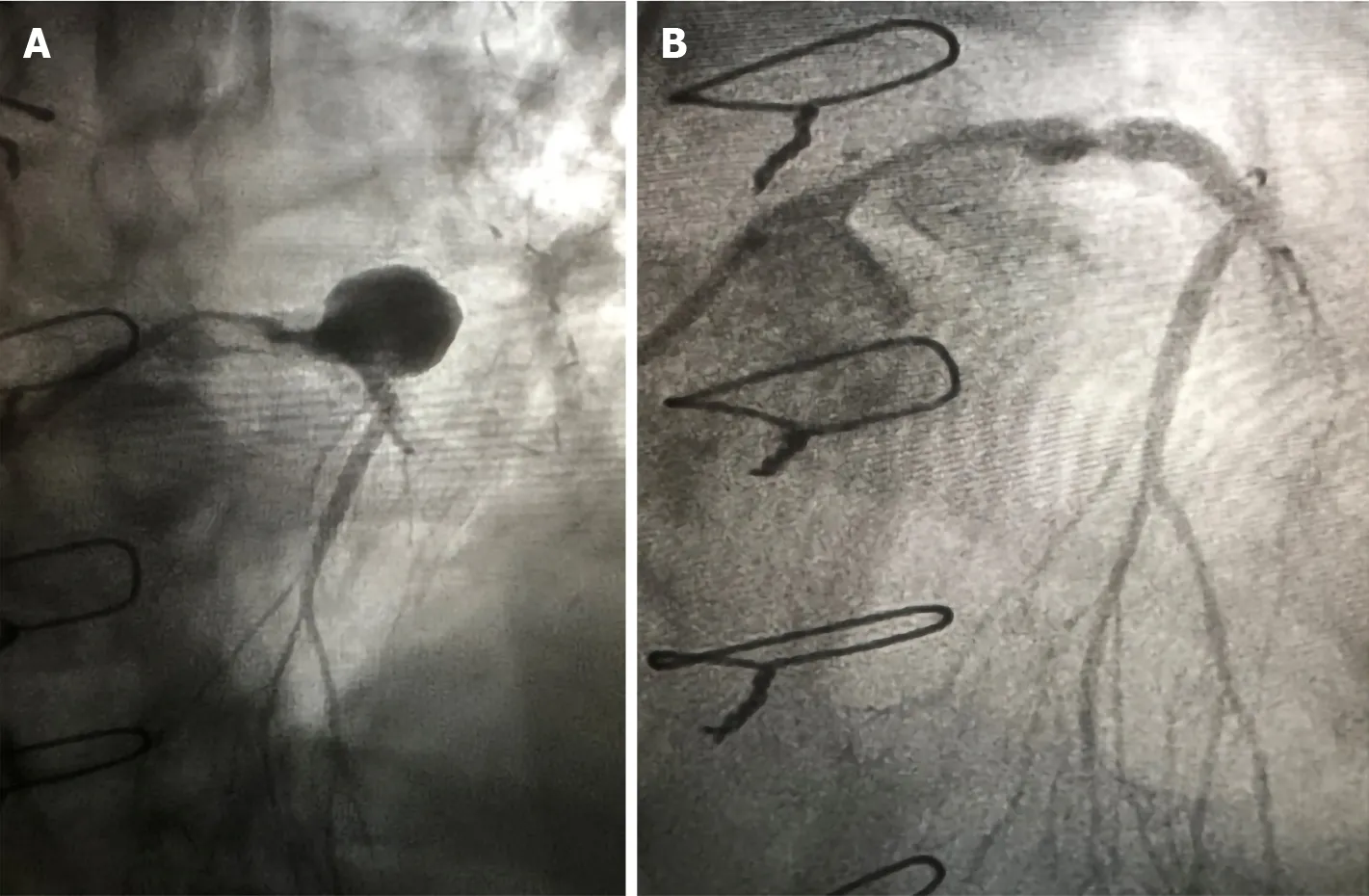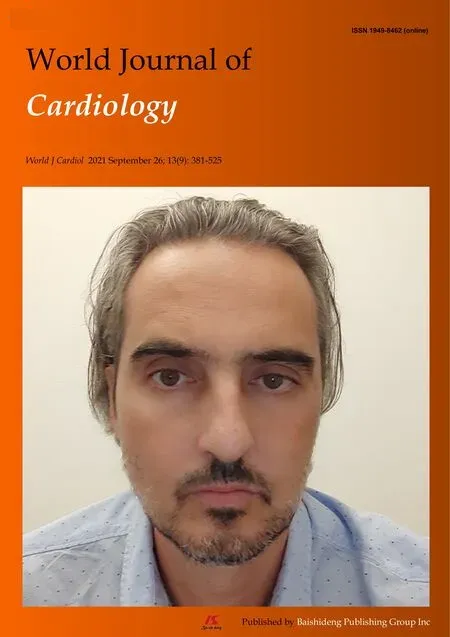Coronary artery aneurysm:A review
Anthony Georges Matta,Nabil Yaacoub,Vanessa Nader,Nicolas Moussallem,Didier Carrie,Jerome Roncalli
Anthony Georges Matta,Vanessa Nader,Department of Cardiology,Toulouse University Hospital,Rangueil,Toulouse 31400,France
Anthony Georges Matta,Nabil Yaacoub,Faculty of Medicine,Holy Spirit University of Kaslik,Jounieh 961,Lebanon
Vanessa Nader,Faculty of Pharmacy,Lebanese University,Hadath 961,Lebanon
Nicolas Moussallem,Division of Cardiology,Faculty of Medicine,Holy Spirit University of Kaslik,Jounieh 961,Lebanon
Didier Carrie,Department of Cardiology,University Hospital Rangueil,Toulouse 31059,France
Jerome Roncalli,Department of Cardiology,University Hospital of Toulouse/Institute Cardiomet,Toulouse 31400,France
Abstract Coronary artery aneurysm (CAA) is a clinical entity defined by a focal enlargement of the coronary artery exceeding the 1.5-fold diameter of the adjacent normal segment.Atherosclerosis is the main cause in adults and Kawasaki disease in children.CAA is a silent progressive disorder incidentally detected by coronary angiography,but it may end with fatal complications such as rupture,compression of adjacent cardiopulmonary structures,thrombus formation and distal embolization.The pathophysiological mechanisms are not well understood.Atherosclerosis,proteolytic imbalance and inflammatory reaction are involved in aneurysmal formation.Data from previously published studies are scarce and controversial,thereby the management of CAA is individualized depending on clinical presentation,CAA characteristics,patient profile and physician experience.Multiple therapeutic approaches including medical treatment,covered stent angioplasty,coil insertion and surgery were described.Herein,we provide an up-to-date systematic review on the pathophysiology,complications and management of CAA.
Key Words:Coronary artery aneurysm;Complications;Atherosclerosis;Coronary artery ectasia
INTRODUCTION
Coronary artery aneurysm (CAA) is a rare clinical entity defined by an abnormal focal dilation of the coronary artery exceeding the 1.5-fold diameter of the adjacent normal segment,whereas coronary artery ectasia describes similar but diffuse lesions involving ≥ 50% of the coronary artery length[1].Thus,aneurysmal coronary disease is seen as focal aneurysm (e.g.,Kawasaki) but also in more diffuse forms (diffuse ectasia).In general,CAAs are divided into two types:saccular when the longitudinal diameter is less than the transverse diameter;and fusiform in the opposite condition[2-4](Figure 1).Fusiform CAAs are commonly found in the left anterior descending artery[2-4].Aneurysmal dilation ≥ 8 mm in diameter or four times higher than reference coronary diameter characterized a giant CAA[5-7].The incidence of true CAA varies from 0.3% to 5.3%[8,9] knowing that most recent studies reported an incidence rate below 1%[10-13].The right coronary artery is most commonly involved followed by left anterior descending artery,circumflex and left main[8,9].A predilection to male gender and proximal coronary segment was described[14].

Figure 1 Coronary angiograms showing saccular aneurysm of the left main (A),saccular aneurysm of the left circumflex (B),fusiform aneurysm of the distal left anterior descending (C) and saccular aneurysm of the bifurcation left anterior descending/diagonal (D).
CAA is usually a silent disorder incidentally detected by coronary angiography or computed tomography (CT) angiography.The wide spectrum of clinical presentations ranging from chest pain to sudden cardiac death results from the development of complications and/or the coexistence of obstructive coronary artery disease[8,15-20].Until now,the management of CAA is individualized depending on clinical manifestations,patient conditions,CAA characteristics,physician experience and preference.A poor long-term prognosis has been attributed to the presence of CAA[21,22].Herein,we provide an up-to-date systematic review on the pathogenesis,complications and management of CAA.
PATHOPHYSIOLOGY
The pathophysiological mechanisms of CAA are not well understood,but atherosclerosis is the main identified etiology in adults and Kawasaki disease in children[5].Atherosclerosis is a chronic progressive transmural inflammatory disease affecting the different vascular layers from the tunica intima to the external elastic lamina,thereby contributing to a weakened vascular wall[23-27].It is worthy to mention that stenotic coronary atherosclerosis and CAA commonly coexist.They share in common several histological patterns like hyalinization,lipid deposition,destruction of coronary layers,focal calcification and fibrosis[23-27].All of these arteriosclerotic modifications on top of the liberation of nitric oxide,which enhances vasodilation,reduce the coronary resistance to intraluminal pressure predisposing it to dilatation and CAA formation.Kawasaki disease is an acute inflammatory syndrome that may infiltrate the arterial wall resulting in acute vasculitis and subsequent aneurysmal dilation[28].Indeed,a high level of tumor necrosis factor-alpha,which is an inflammatory cytokine,was linked to the breakdown of elastin and the development of CAA[29].Currently,coronavirus disease 2019 markedly increased the incidence of Kawasaki disease with cardiovascular involvement in children and young adults[30].Other vasculitic disorders like Takayasu arteritis,polyarteritis nodosa,systemic lupus erythematosus and rheumatoid arthritis may lead to CAA[31,32].
Otherwise,matrix-degrading enzymes play a pivotal role in the pathogenesis of CAA.A proteolytic imbalance caused by a high level of matrix metalloproteinases(MMP-2,-3,-9,-12) and a reduced level of matrix metalloproteinase inhibitors (tissuespecific inhibitors of metalloproteinases,TIMP-1,-2,-3,-4) resulting in connective tissue proteins and arterial wall matrix degradation,is reported in aneurysmal vessels[33-35].Genetic susceptibility such as variants on chromosome 9p21.3,HLA-DR B1*13,DR16,DQ2,DQ5 and several hereditary disorders such as Marfan syndrome and Ehler-Danlos were linked to CAA[9,36].Infectious processes that directly invade the vascular wall or provoke immune complex deposition contribute to CAA formation[37].
Lastly,CAA may complicate coronary angioplasty with stent implantation[38-40].Aneurysmal formation was observed with bare metal stents,drug eluting stents and biodegradable stents[38-40].Coronary dissection,oversizing,stent malapposition,high pressure balloons and local wall injury are the main mechanisms associated to stent-related CAA[41,42].
COMPLICATIONS
Most patients with CAA are asymptomatic,and the occurrence of clinical manifestations is related to a concomitant atherosclerotic coronary artery disease or to the development of complications.Local thrombosis,distal embolization,aneurysm rupture,coronary spasm and compression of adjacent structure by massive enlargement of CAA are the most observed complications[17,18,43,44] (Figure 2).The stagnation of blood flow and the reduction of shear stress in CAA contribute to thrombus formation and subsequent potential distal embolization[45].Several published cases reported the presence of thrombus inside the aneurysm[46,47] and described myocardial wall motion abnormalities following distal embolization in patients with CAA[48].Theoretically,CAA does not have enough intact smooth muscle to produce significant vasoconstriction knowing that smooth muscle hypercontractility is implicated in the pathophysiological mechanism of coronary artery spasm[49].However,Boveet al[50] were the first to describe a recurrent angina linked to spasm of aneurysmal coronary arteries.The rupture of CAA is rare,unpredictable and a serious life-threatening condition that results in cardiac tamponade and sudden death.Since previously published data[51-53],the incidence of rupture of CAA was dramatically decreased[54].An excessively enlarged CAA may compress the surrounding adjacent cardiopulmonary structures like the right atrium[55],the right ventricular wall[55],the pulmonary artery and the tricuspid valve[56].

Figure 2 An illustration of the pathophysiology (A),types (B),complications (C) and therapeutic (D) modalities for coronary artery aneurysm.
MANAGEMENT OF CAA
Until now,there are no standardized international recommendations for the management of CAA due to the lack of data from randomized clinical trials.Most of the available data are based on case series and anecdotal evidence.The management of CAA is individualized and depends on clinical presentation (silent or symptomatic),characteristics of CAA (location,size,shape,evolution,etiology),patient profile (age,comorbidities,cardiovascular risk factors) and physician experience.Different approaches including medical treatment,percutaneous coronary intervention (stent angioplasty and coil embolization) and surgical excision were priorly performed.Indeed,the optimal therapeutic strategy leading to the best outcome was not yet defined due to the absence of comparative studies.Coronary angiography is the invasive gold standard tool to assess the anatomic features of CAA,while coronary CT is the alternative non-invasive technique of choice for the follow-up[57].
Medical management
First of all,an intense control of cardiovascular risk factors is advocated in patients with CAA regardless of the presence of concomitant obstructive coronary artery disease[58].Basing on the association between the overexpression of angiotensinconverting enzyme and aneurysm formation,it was hypothesized that angiotensinconverting enzyme inhibitors and angiotensin II receptor blockers may slow the progression of CAA[59].Also,the use of statins in CAA patients is desirable.A beneficial role was attributed to statins by inhibiting the expression of matrix metalloproteinases,which play a crucial role in the physiological mechanism of aneurysm formation[60].Otherwise,the proper indication of anti-thrombotic regimen for the management of CAA is a matter of debate noticing that data from previously published studies are controversial.
Despite the risk of thrombus formation and distal embolization described above,few retrospective studies conclude that anticoagulation strategy is unbeneficial by showing a similar rate of thrombotic events in patients with and without CAA[61-63].Contradictory results were revealed by Warisawaet al[21] and Bamanet al[57] who showed greater rates of 5-year mortality and major cardiovascular adverse events(MACE) in patients with CAA.A recently published study found that prescribing oral anticoagulation led to positive outcomes in patients with coronary artery ectasia by reporting 0% of MACE in patients treated with oral anticoagulation compared to those who did not receive anti-thrombotic therapy after 49 mo of follow-up[22].Therefore,coronary artery ectasia was identified as an independent predictor of cardiac events in patients presenting with acute coronary syndromes[22].Myocardial infarction,MACE and death were two to four times higher in patients with coronary artery ectasia[22].However,it is worthy to mention that prolonged anti-thrombotic therapy may provoke complications,such as bleeding.Lastly,intravenous immunoglobulin therapy in Kawasaki disease promotes CAA regression and decreases the incidence of MACE[64].
Percutaneous coronary interventions
Percutaneous coronary intervention (PCI) is a relatively new therapeutic option allowing to exclude CAA when the clinical and/or anatomical risk is high (Figure 3).Several techniques were reported in the literature,like covered stent implantation[65],coil embolization and stent-assisted coil insertion[66].Conventionally,PCI is the preferred approach to exclude smaller CAA,while surgical approach is preferred for the larger aneurysms[67].Several limitations like difficulty of stent delivery,occlusion of side branches and high percentage of restenosis were observed with covered stent angioplasty[68].Bare metal stents were previously preferred over polytetrafluoroethylene covered stents due to the lower incidence of thrombosis and restenosis[69].The last generation of covered stents,such as PK Papyrus stents,achieve a greater bending flexibility and a smaller crossing profile compared to the traditional sandwich designed stents that allow sealing of perforations and exclude aneurysms[70].Therefore,stent-assisted coil insertion technique is favored over coil embolization in the management of wide-necked CAA because it reduces the risk of occlusion of the parent coronary vessel and rupture of CAA[66].

Figure 3 Coronary angiograms showing a giant coronary artery aneurysm of the proximal left anterior descending artery (A) excluded by implanting a bare metal stent with nonsignificant residual stenosis (B).
Previous studies investigating the outcomes of PCI performed in patients with CAA in the setting of acute myocardial infarction found a worst prognosis,thereby showing higher rates of procedural failure,mortality,no-reflow,stent thrombosis,distal embolization and target vessel revascularization[10-13,71].Performing PCI in the setting of aneurysmal coronary arteries imposes technical challenges for physicians,such as appropriate sizing,landing zone assessment and thrombus burden.As a result,it is rare to intervene in asymptomatic patients with CAA.
Surgical interventions
Different surgical techniques have been described including aneurysmectomy with or without coronary artery bypass graft,aneurysm ligation,resection and marsupialization[72].Indeed,the optimal surgical approach has not yet been defined.Overall,surgery is considered an alternative adequate therapeutic strategy for the management of symptomatic patients unsuitable for PCI,patients with concomitant obstructive coronary artery disease,CAA involving the large bifurcation or the left main,complicated CAA and giant CAA at high risk of rupture[72,73].
Imaging modalities for detection of CAA
A recently published study showed that CT angiography is superior to cardiac magnetic resonance imaging for detection,risk stratification and follow-up of CAA in patients with Kawasaki disease[74].Also,CT angiography has already proven its value for the assessment of the diameter of coronary arteries in adults and patients with Kawasaki disease when compared to coronary angiography[75-78].Indeed,the sensitivity of CT angiography for detection of CAA and related complications is remarkably high.Because radiation exposure is associated with an increase in lifetime cancer risk,especially in children,the lack of radiation exposure is the main described benefit to cardiac magnetic resonance imaging over coronary angiography and CT angiography for CAA detection[74].Lastly,CT angiography provides accurate data concerning the coronary anatomy,calcification,luminal diameter,thrombi and aneurysmal features[79].It represents the imaging of choice for the long-term monitoring of CAA[57].
CONCLUSION
Usually,CAA is an incidental angiographic finding associated to atherosclerosis.The natural history of CAA is not well understood,but it is a progressive silent disease.Future prospective comparative trials to define the appropriate strategy and the optimal time to intervene are required in order to avoid the development of serious complications,especially in those with concomitant obstructive coronary artery disease.
 World Journal of Cardiology2021年9期
World Journal of Cardiology2021年9期
- World Journal of Cardiology的其它文章
- Effects of exercise training on diastolic and systolic dysfunction in patients with chronic heart failure
- Red blood cell distribution width in elderly hospitalized patients with cardiovascular disease
- Percutaneous coronary intervention of totally occluded coronary venous bypass grafts:An exercise in futility?
- Patients’ time in therapeutic range on warfarin among atrial fibrillation patients in Warfarin Medication Therapy Adherence Clinic
- Intensive lipid-lowering therapy,time to think beyond low-density lipoprotein cholesterol
- Sodium glucose cotransporter 2 inhibitors:New horizon of the heart failure pharmacotherapy
